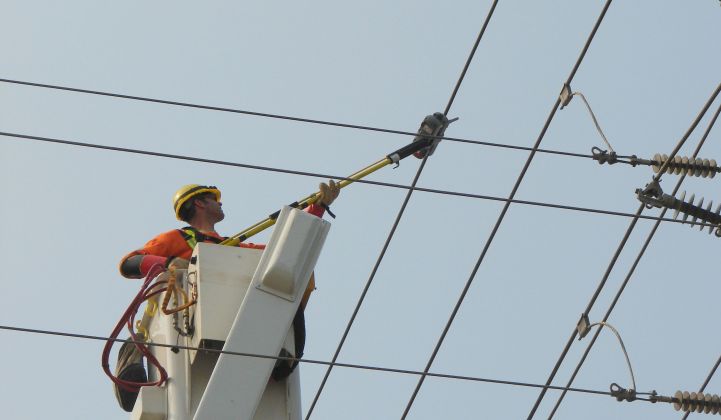When it comes to grid sensors, the more accurate a device is, the costlier and more complicated it is to install and maintain. One example of this is line post sensors, the industry-standard technology used to get voltage readings with better than 1 percent accuracy -- a technically tricky but very important task for monitoring the grid.
Line post sensors are mounted onto utility poles and require planned outages, bucket trucks and several hours to install. They also need their own electricity source, which requires cables and transformers to convert and clean grid power, or batteries that require replacement every few years.
A type of sensors known as “bird on a wire” devices are available from companies like GridSense, Sentient Energy, PowerSense, QinetiQ and others. They’re cheaper than line post sensors and can be hung from power lines by a utility worker using a “hot stick" in a matter of minutes, not hours. They’re also inductively powered from the power lines they're attached to, which means no power connectors or batteries are needed. But while they’re able to capture lots of critical grid data, they’re less accurate when it comes to measuring voltage.
Sensor maker Tollgrade Communications says its new LightHouse MV Power Sensor solves this problem, achieving voltage measurements with 0.5 percent accuracy -- an unprecedented claim from an inductively powered sensor, which generally hover at around 2 percent.
The device comes with a host of features that make it an attractive alternative to a number of other devices being used by utilities today, Erik Christian, vice president of smart grid for the Pittsburgh, Penn.-based company, said in a Tuesday interview.
“We think this is something that’s revolutionary in the market, and so far the response has been very strong,” he said. While the company hasn’t named any customers for the new sensor, it does have a number of utilities using its LightHouse platform to manage its existing medium-voltage (MV) current and e-field sensors, including Duke Energy in the United States, Toronto Hydro in Canada, Western Power Distribution in the U.K. and ELO Sistemas in Brazil -- and the MV Power Sensor plugs right into that platform, he said.
Looking at Tollgrade’s devices side by side, the new MV Power Sensor stands out for the addition of a voltage divider -- a disc-studded tube attached to its underside. “We’re able to get accurate voltage at half of a percent, by being attached to the neutral and using this voltage divider,” he said:

As for how Tollgrade achieves its balance of high-accuracy voltage sensing and the low-power imperatives of an inductively powered system, “There’s a lot of secret sauce that allows our technology to do this, where other technologies couldn’t measure accurate voltage,” he said.
“We’ve developed a lot of technology in the sensor that allows us to get to very low current thresholds, which differentiates us from a lot of the competition,” he added. Tollgrade has long touted its ability to obtain accurate measurements at farther-out points in the grid, where voltages are weaker.
All of this comes at a price that’s roughly half that of a line post sensor and about one-fifth the cost of optical sensors, which use light to measure voltage, current and other grid parameters, he said.
While he didn’t say which optical product Tollgrade was using for comparison, one of the few on the market came from OptiSense Networks, which filed for Chapter 7 bankruptcy protection last month. OptiSense did have deployments underway with utilities including Alabama Power, which provided some data on how increasing voltage accuracy leads to significant increased benefits from volt/VAR optimization (VVO) and conservation voltage reduction (CVR) schemes, as shown in the following figure.

“What this power sensor opens up is a lot of the next-generation applications,” like CVR and VVO, or fault location, isolation and service restoration (FLISR), he said. Beyond that, rooftop solar PV and other distributed generation resources have impacts on grid voltage that could require highly accurate voltage measurements to manage.
“These are the things our customers tell us are keeping them up at night,” Christian said. “The starting point is software from a distribution management system or other solutions -- but we need to get all the information into the system to make it work.”
Tollgrade’s claims will face quite a bit of scrutiny, to be sure, but its MV Power Sensor certainly stands out in terms of price point and form factor. In the meantime, other sources of data are emerging for the grid, ranging from secondary transformer monitors to sensor-enabled smart meters, to help fill in the blank spots on utility maps.



